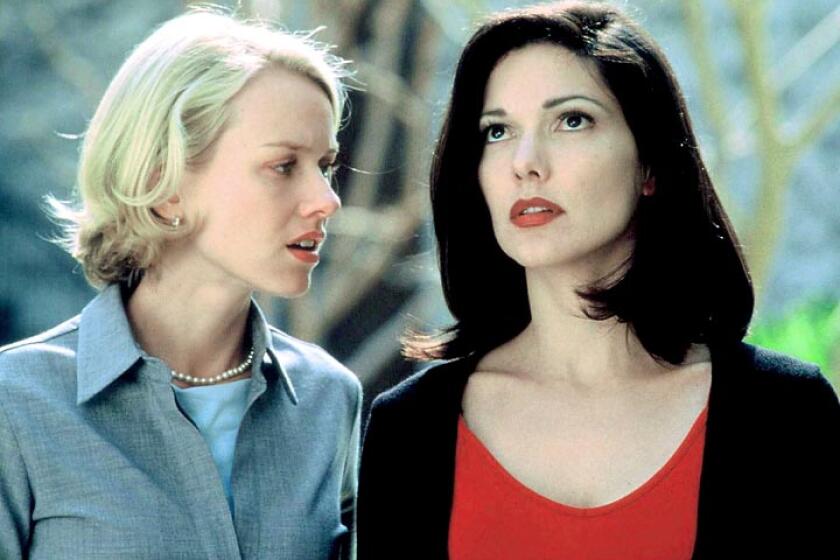MOVIE REVIEW : ‘Wings of Desire’ Soars With Angelic Beauty, Optimism
- Share via
Where do Berliner angels hang out, when they’re not on steeples, in subways or in shiny BMW showrooms? In libraries, of course. What do they wear? Overcoats, mufflers and ponytails. What do they do? They listen. Unseen, unbidden, they listen to every unspoken word, rising like a sigh to become a great breathed-in chord above the city.
They see, they listen, they comfort. And they “assemble, testify, preserve,” although they do not intercede. They keep their distance, keep their word, keep their eternal cool.
But what happens if an angel yearns for the most ordinary human pleasures--to feed the cat, “like Philip Marlowe”; to find his fingers blackened from his newspaper, to blow the steam from a cup of coffee? To fall in love. Ah, then he finds himself at the center of “Wings of Desire” (at the Nuart), a magnificent film of sublime beauty and contagious optimism.
It catches director Wim Wenders in an uncommonly buoyant mood, joined on the script by an old associate: poet, novelist, playwright and screenwriter Peter Handke. The lovers of “Wings of Desire” are a pair neither of the air nor the earth: an angel, Damiel--played with brimming tenderness and empathy by Bruno Ganz (from Wenders’ “The American Friend”)--and Marion, a trapeze artist whose molting wings match the seedy condition of the Circus Alekan, folding the next day. She’s played by the radiant Solveig Dommartin, Wenders’ own muse for the last four years, who handled the greater part of her own trapeze work.
Wenders’ other close collaborator--his mind’s eye--is the legendary cinematographer Henri Alekan (the “Circus Alekan” in-joke, explained). Now 79, Alekan created the sumptuous black and white of “Beauty and the Beast” for Cocteau under the strictures of the Nazi Occupation; he worked with Abel Gance and Raul Ruiz, William Wyler, Marcel Carne, Jules Dassin and Joseph Losey, among others.
And he worked with Wenders once before, on the anguished, stunning-looking study of the movie business, “The State of Things.” Here, with his 80-year-old gaffer, Louis Cochet, Alekan’s visual power, softly swirling and mysterious, is unsurpassed. (Purists may notice that he does it with lights and lenses and filters, not fog machines.)
In the film makers’ eyes, the angelic life lacks more than a little something. These patient, eternal guides even see the world in black and white. It isn’t until Marion--pensive about her last performance, even uncharacteristically nervous--begins to encroach on Damiel’s consciousness that the film begins to surge into color, until by the end everything is colored but one unrehabilitated angel. One thread of the story is held by a very old Berliner, significantly named Homer (Curt Bois, with a film history as long as Alekan’s). His worry is that when his “sing-song voice” is gone, “mankind will lose its storyteller” and, in turn, its childhood. His poignant cry is that peace seems so uninteresting: “No one has . . . succeeded in singing an epic of peace . . . its inspiration doesn’t endure.” The blond angel Cassiel (Otto Sander) is virtually his only audience, nurturing, supportive.
Of all the adults wandering around Berlin, only Peter Falk seems to sense the presence of Damiel and Cassiel. Falk plays a meditative American actor brought over to do a senseless-sounding detective film set in Berlin in 1945.
Deprived of his Columbo trench coat, the actor spends precious time picking a hat that may define his character more eloquently than the script, and more time doing pencil sketches of his fellow actors. It is a performance of perfect pitch: To hear Falk say, “What a dear face!” as he tries to capture a beaming, older actress has a richness all its own.
The movie-in-production allows Wenders to create scenes that mix past and present in a city that bears the scars of both. As Falk is driven through divided Berlin, the street scenes in the background are from newsreel footage of 1945. In a dazed, devastated city, women sift with blank faces through mountains of rubble or turn away from the bodies of bombing victims, some of them tiny children.
Damiel does risk his lease on eternity for the possibility of love, and his entry into a feeling world has a poet’s precision in observation and an actor’s delicious subtlety. The everyday habits of life astonish Damiel: a realistic bedroom setup in a furniture display window he finds hilarious. (Then there’s Damiel’s taste in clothes, once he has shed that impeccable heavenly overcoat and muffler. Color is indeed new to him. Angels may do good, the film makers suggest slyly, but where was it written they have good taste ?)
The thrilling final sequence makes “Wings of Desire” a strange duck by today’s supercool standards--this passionate declaration of the need for trust, love and commitment. The film’s power is that its poetry, rooted in the commonplace, can soar to include the miraculous--the crunch of an apple, the tender lacing-up of a child’s shoe, the gasoline-slick rainbow in a puddle.
One note: “Wings of Desire” won Wenders the best director award at the 1987 Cannes Film Festival, plus seven other major festival awards. Yet it is scheduled to run but one week at the Nuart. How can this be? Track shoes again seem in order.
‘WINGS OF DESIRE’
An Orion Classics Release of a French/German co-production between Argos Films, Paris and Road Movies, Berlin, in association with Westdeutscher Rundfunk, Koln. Producers Wim Wenders, Anatole Dauman. Executive producer Ingrid Windisch. Director Wenders. Screenplay Wenders, in collaboration with Peter Handke. Camera Henri Alekan. Personal assistant to Alekan Louis Cochet. Second-unit photography Peter Ch. Arnold, Frank Blasberg, Peter Braatz. Art director Heidi Ludi. Costumes Monika Jacobs. Sculptor Claude Lalanne. Music Jurgen Knieper. Editor Peter Przygodda. Sound Jean-Paul Mugel, Axel Arft. With Bruno Ganz, Solveig Dommartin, Otto Sander, Curt Bois, Peter Falk.
Running time: 2 hours, 10 minutes.
Times-rated: Mature.
More to Read
Only good movies
Get the Indie Focus newsletter, Mark Olsen's weekly guide to the world of cinema.
You may occasionally receive promotional content from the Los Angeles Times.










